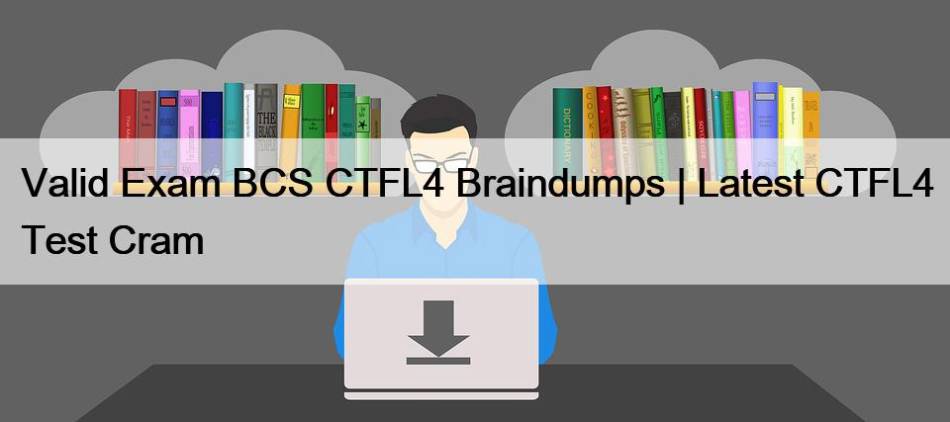Most Popular
 Updated Microsoft AZ-204 Exam Questions in PDF Document
Updated Microsoft AZ-204 Exam Questions in PDF Document
P.S. Free & New AZ-204 dumps are available on Google ...
 2025 100% Free ESRS-Professional–Professional 100% Free Reliable Test Simulator | Exam ESRS Professional Certification Exam Introduction
2025 100% Free ESRS-Professional–Professional 100% Free Reliable Test Simulator | Exam ESRS Professional Certification Exam Introduction
If you just free download the demos of our ESRS-Professional ...
 Apigee-API-Engineer Reliable Test Sims & Latest Apigee-API-Engineer Real Test
Apigee-API-Engineer Reliable Test Sims & Latest Apigee-API-Engineer Real Test
Google provides the most reliable and authentic Google Apigee-API-Engineer Exam ...



Valid Exam BCS CTFL4 Braindumps | Latest CTFL4 Test Cram

Our test engine has been introduced for the preparation of CTFL4 practice test and bring great convenience for most IT workers. It will make you feel the atmosphere of the CTFL4 actual test and remark the mistakes when you practice the exam questions. We strongly recommend that you should prepare your CTFL4 Exam PDF with our test engine before taking real exam.
If you fail CTFL4 exam with our CTFL4 exam dumps, we will full refund the cost that you purchased our CTFL4 exam dumps. However, our promise of "No help, full refund" doesn't shows our no confidence to our products; oppositely, it expresses our most sincere and responsible attitude to reassure our customers. With our professional CTFL4 Exam software, you will be at ease about your CTFL4 exam, and you will be satisfied with our after-sale service after you have purchased our CTFL4 exam software.
>> Valid Exam BCS CTFL4 Braindumps <<
Latest CTFL4 Test Cram, CTFL4 Actual Test Answers
Our CTFL4 certification has great effect in this field and may affect your career even future. CTFL4 real questions files are professional and high passing rate so that users can pass exam at the first attempt. High quality and pass rate make us famous and growing faster and faster. Many candidates compliment that CTFL4 Study Guide materials are best assistant and useful for qualification exams, and only by practicing our CTFL4 exam braindumps several times before exam, they can pass CTFL4 exam in short time easily.
BCS CTFL4 Exam Syllabus Topics:
| Topic | Details |
|---|---|
| Topic 1 |
|
| Topic 2 |
|
| Topic 3 |
|
| Topic 4 |
|
| Topic 5 |
|
BCS ISTQB Certified Tester Foundation Level CTFL 4.0 Sample Questions (Q160-Q165):
NEW QUESTION # 160
Which of the following statements is TRUE'?
- A. Functional testing can be applied to all test levels, while non-functional testing can be applied only to system and acceptance test levels.
- B. Black-box test techniques and experience-based test techniques may be applicable to both functional testing and non-functional testing
- C. Functional testing focuses on what the system is supposed to do, while white-box testing focuses on how well the system does what it is supposed to do
- D. Unlike functional testing, non-fundional testing can only be applied to conventional systems, not artificial intelligence-based system.
Answer: B
Explanation:
Statement D is correct. According to the ISTQB CTFL syllabus, both black-box test techniques (which focus on testing without internal knowledge of the application) and experience-based test techniques (which rely on testers' experience and intuition) can be applied to both functional and non-functional testing. Functional testing is concerned with what the system does, whereas non-functional testing looks at how the system performs under certain conditions. These techniques are versatile and can be employed to address both these aspects.
NEW QUESTION # 161
An alphanumeric password must be between 4 and 7 characters long and must contain at least one numeric character, one capital (uppercase) letter and one lowercase letter of the alphabet.
Which one of the following sets of test cases represents the correct outcome of a two-value boundary value analysis applied to the password length? (Note: test cases are separated by a semicolon)
- A. 1xB: aB11: 99rSp: 5NnN10; 4NnN10T; 44ghWn19
- B. 1xA;aB11;Pq1ZZab;7iDD0a1x
- C. aB11;99rSp:5NnN10;7iDD0a1x
- D. 1RhT;rSp53;3N3e10;8sBdby
Answer: D
Explanation:
The correct outcome of a two-value boundary value analysis applied to the password length is the set of test cases represented by option D. Boundary value analysis is a test design technique that focuses on the values at the boundaries of an equivalence partition, such as the minimum and maximum values, or the values just above and below the boundaries. A two-value boundary value analysis uses two values for each boundary, one representing the valid value and one representing the invalid value. For example, if the valid range of values is from 4 to 7, then the two values for the lower boundary are 3 and 4, and the two values for the upper boundary are 7 and 8. The test cases in option D use these values for the password length, while also satisfying the other requirements of the password, such as containing at least one numeric character, one capital letter, and one lowercase letter. The test cases in option D are:
1RhT: a 4-character password that is valid
rSp53: a 5-character password that is valid
3N3e10: a 6-character password that is valid
8sBdby: an 8-character password that is invalid The test cases in the other options are incorrect, because they either use values that are not at the boundaries of the password length, or they do not meet the other requirements of the password. For example, the test cases in option A are:
1xA: a 3-character password that is invalid, but it does not contain a capital letter aB11: a 4-character password that is valid Pq1ZZab: a 7-character password that is valid
7iDD0a1x: an 8-character password that is invalid Reference: ISTQB Certified Tester Foundation Level (CTFL) v4.0 sources and documents:
ISTQB Certified Tester Foundation Level Syllabus v4.0, Chapter 2.2.1, Black-box Test Design Techniques1 ISTQB Glossary of Testing Terms v4.0, Boundary Value Analysis, Equivalence Partition2
NEW QUESTION # 162
The acceptance criteria associated with a user story:
- A. are often written in a rule-oriented format using the template referred to as "Given/When/Then"
- B. are often documented following in rule-oriented format using the following template: "As a [role], I want [feature], so that I can [benefit]"
- C. can be written in different formats and represent an aspect of a user story referred to as confirmation' of the so called "3 C's"
- D. must be written in one of the two following formats: scenario-oriented or rule-oriented
Answer: C
Explanation:
The acceptance criteria associated with a user story are the conditions that must be met for the user story to be considered done and to deliver the expected value to the user. They are often written in different formats, such as rule-oriented, scenario-oriented, or table-oriented, depending on the nature and complexity of the user story. They represent an aspect of a user story referred to as confirmation, which is one of the so called "3 C's" of user stories. The other two aspects are card and conversation. Card refers to the concise and informal description of the user story, usually following the template: "As a [role], I want [feature], so that I can [benefit]". Conversation refers to the ongoing dialogue between the stakeholders and the team members to clarify and refine the user story and its acceptance criteria. Therefore, option C is the correct answer.
NEW QUESTION # 163
A typical objective of testing is to ensure that:
- A. there are no defects in a software that is about to be released
- B. testing is used to drive the development of a software
- C. a software has been tested using a combination of test techniques
- D. a software has been properly covered
Answer: C
Explanation:
This answer is correct because a typical objective of testing is to ensure that a software has been tested using a combination of test techniques, such as black-box, white-box, or experience-based techniques, that are appropriate for the test objectives, test levels, and test types. Testing using a combination of test techniques can increase the effectiveness and efficiency of testing, as different techniques can target different aspects of the software quality, such as functionality, usability, performance, security, reliability, etc. Testing using a combination of test techniques can also reduce the risk of missing defects that could be detected by one technique but not by another. Reference: ISTQB Foundation Level Syllabus v4.0, Section 2.3.1.1, Section 2.3.2
NEW QUESTION # 164
An application is subjected to a constant load for an extended period of time as part of a performance test While running this test, the response time of the application steadily slows down, which results in a requirement not being met This slowdown is caused by a memory leak where the application code does not properly release some of the dynamically allocated memory when it is no longer needed. Which of the following statements is TRUE?
- A. The slowdown is a defect while the memory leak is an error.
- B. The slowdown is a failure while the memory leak is a defect
- C. The slowdown is an error; the memory leak is a defect.
- D. The slowdown is a defect; the memory leak is a failure.
Answer: B
Explanation:
In software testing terminology, a failure is an observable deviation of the software from its expected behavior. A defect (or bug) is the cause of the failure in the software's code. In this case, the observed slowdown is the failure, while the underlying memory leak in the application code is the defect causing this failure. This distinction is clearly outlined in the ISTQB CTFL Syllabus v4.0, which differentiates between failures (observable issues) and defects (underlying issues in the code).
NEW QUESTION # 165
......
We cannot overlook the importance of efficiency because we live in a society emphasize on it. So to get our latest CTFL4 exam torrent, just enter the purchasing website, and select your favorite version with convenient payment and you can download our latest CTFL4 exam torrent immediately within 5 minutes. This way you can avoid the problems in waiting for arrival of products and you can learn about the knowledge of CTFL4 Quiz guides in a short time. Latest CTFL4 exam torrent can vividly embody the spirits and effort we have put into them. And the power of our CTFL4 test prep permit you to apprehend the essence of the exam. All elites in this area vindicate the accuracy and efficiency of our CTFL4 quiz guides.
Latest CTFL4 Test Cram: https://www.freepdfdump.top/CTFL4-valid-torrent.html
- Get Marvelous Valid Exam CTFL4 Braindumps and First-grade Latest CTFL4 Test Cram 🏹 Search for ( CTFL4 ) and obtain a free download on ▶ www.testsdumps.com ◀ 📳CTFL4 Simulated Test
- Online CTFL4 Tests 🚅 Online CTFL4 Tests 🔨 New CTFL4 Braindumps Ebook 🥭 Search for ⮆ CTFL4 ⮄ and download it for free immediately on ⇛ www.pdfvce.com ⇚ 🦡Reliable CTFL4 Test Online
- Free PDF Quiz Updated BCS - Valid Exam CTFL4 Braindumps 🧹 Copy URL ( www.lead1pass.com ) open and search for ( CTFL4 ) to download for free 🚑Exam CTFL4 Certification Cost
- Exam CTFL4 Outline 🐏 Exam CTFL4 Outline 🛫 Reliable CTFL4 Test Online 🔷 Open 《 www.pdfvce.com 》 and search for 【 CTFL4 】 to download exam materials for free 🕓Practice CTFL4 Test Engine
- The Benefits of CTFL4 Certification 😍 Download ➥ CTFL4 🡄 for free by simply searching on ➥ www.passtestking.com 🡄 💼Reliable CTFL4 Test Online
- 100% Pass Quiz 2025 CTFL4: Marvelous Valid Exam ISTQB Certified Tester Foundation Level CTFL 4.0 Braindumps 👆 Enter “ www.pdfvce.com ” and search for ☀ CTFL4 ️☀️ to download for free 🕦CTFL4 Boot Camp
- Pass Guaranteed Quiz BCS - CTFL4 - ISTQB Certified Tester Foundation Level CTFL 4.0 Unparalleled Valid Exam Braindumps 🍽 Easily obtain ⮆ CTFL4 ⮄ for free download through { www.lead1pass.com } 🎱Latest CTFL4 Exam Registration
- 100% Pass Quiz 2025 CTFL4: Marvelous Valid Exam ISTQB Certified Tester Foundation Level CTFL 4.0 Braindumps 👔 Copy URL 「 www.pdfvce.com 」 open and search for ( CTFL4 ) to download for free 🔖Exam CTFL4 Certification Cost
- 100% Pass Fantastic BCS - Valid Exam CTFL4 Braindumps 🦩 Download ➽ CTFL4 🢪 for free by simply entering 「 www.pdfdumps.com 」 website 🥊Exam CTFL4 Certification Cost
- Practice CTFL4 Test Engine 🚁 CTFL4 Real Questions 🧼 Reliable CTFL4 Braindumps Free 🦳 Search for 「 CTFL4 」 and download it for free on ✔ www.pdfvce.com ️✔️ website 🌎CTFL4 Prepaway Dumps
- CTFL4 New Dumps Ppt 🐣 CTFL4 Practice Guide ☎ CTFL4 Real Questions 🐰 Search for ⮆ CTFL4 ⮄ and download it for free immediately on 《 www.testkingpdf.com 》 🚑CTFL4 Prepaway Dumps
- CTFL4 Exam Questions
- upgradeskills.co.in learn.stmarysfarm.com skillboostplatform.com ds.jscode.vip foito.co swift-tree.dev beautyacademy.com.tw maaalfarsi.com qsm-consulting.ma ole.anima.rs
Tags: Valid Exam CTFL4 Braindumps, Latest CTFL4 Test Cram, CTFL4 Actual Test Answers, Exam CTFL4 Labs, CTFL4 Latest Exam Test